* (restored)

‘Japanese cinematic and artistic experiments gained an international recognization during the 1950s. The excitement and attention was noticed in Europe and especially in France through articles and critics published in “les Cahiers du cinema”. The future characters of the “Nouvelle Vague” were already praising the potentials of the content and the form of those Japanese images. As a consequence, the number of films produced, and the cinema audience reached a peak in the 1960s and emerged as long as the Japanese new wave movement, major avant garde filmmakers and fine artist such as Takahiko iimura: and Toshio Matsumoto moving from documentary into fiction film, to experimental videos.
‘Japanese psychedelic film developed out of the drug experiences of the early sixties, exploding the familiar categories of thought and questioning the constants of perception. Emerging in the mid-sixties, structural film stood in the same tradition and treated intensively cinematic perception, the confrontation of object and image, and reproductions of reality. It was predominantly concerned with formal problems rather than with narrative content; in order to focus on the medium of film as such, it was necessary to reduce the narrative element as far as possible. The methods of structural film include cut frequencies of one frame, films consisting of only a single camera movement, 50-fold print-outs of an original image and other formal experiments.
‘In the sixties and seventies a diverse group of artists from Japan formed round the term “Fluxus”, coined by the Lithuanian-born American artist George Macunias. Like the Dadaism of the twenties and Marcel Duchamp, who attacked (and thereby extended) the bourgeois concept of art with ready-mades, mixed media and conceptual art, the Fluxus artists wanted to point to the imbalance in social structures with radically conceived and humorous concerts, happenings, exhibitions and films.
‘While the feature film, within its own specific dramaturgy, follows a psychologically motivated linear plot, the experimental film seeks to tap dimensions beyond the usual narrative structures. It strives to render both social and cinematic conventions visible by changing their rules and patterns – for example, by cutting away, adding, distancing, reversing or re-shuffling. This method of working with foreign, found material is called “found footage film”. Japanese video artists in particular found, and still find, an inexhaustible fund of material in television. By waiving narrative structures, making the medium itself the subject and using techniques of distancing, this method makes the viewer aware of the illusory effect of narrative film. The film material itself becomes the subject of the film, or is used to reveal inner states.’ — collaged
___
Stills
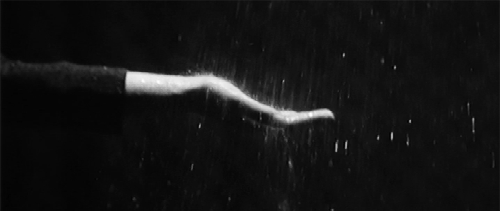

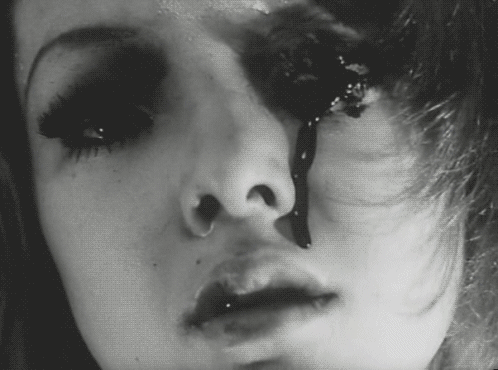
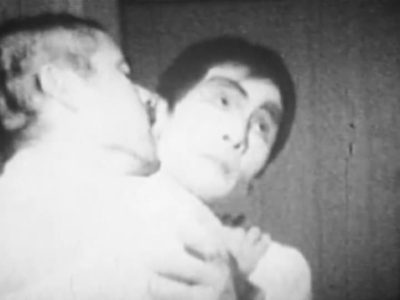
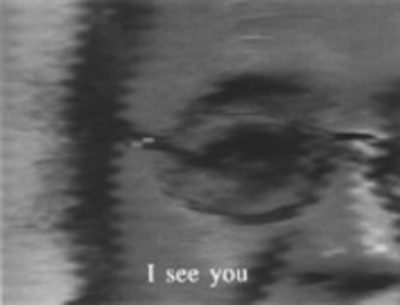

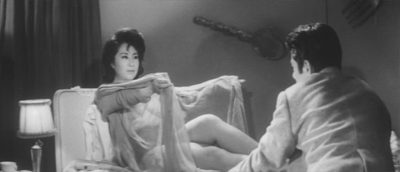
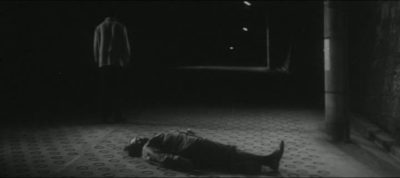
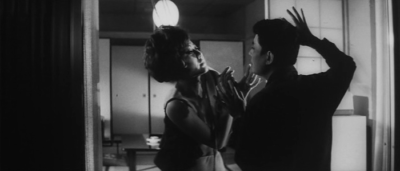
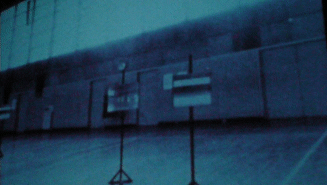







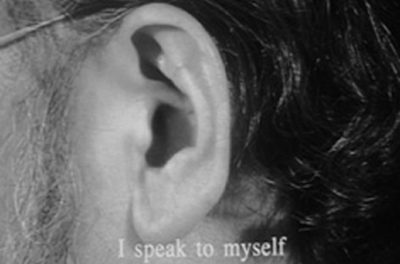

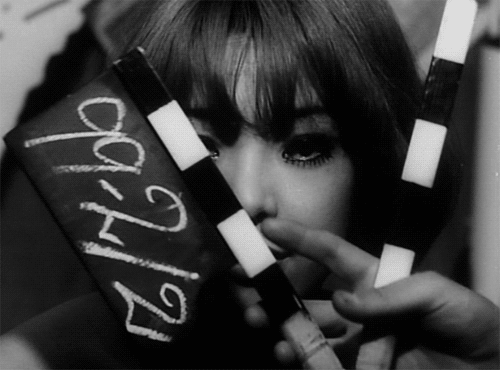



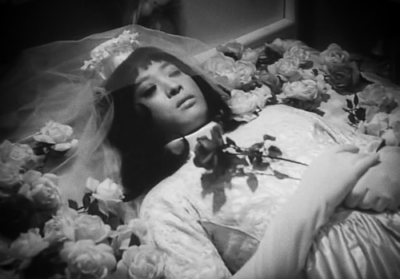

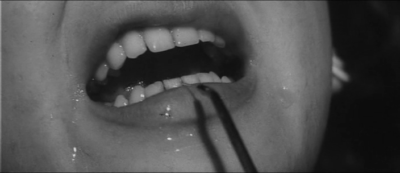
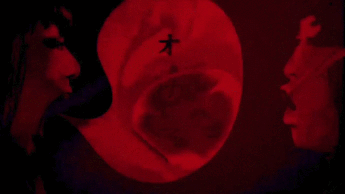
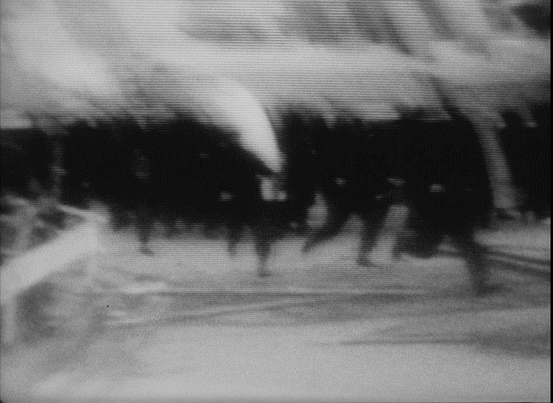
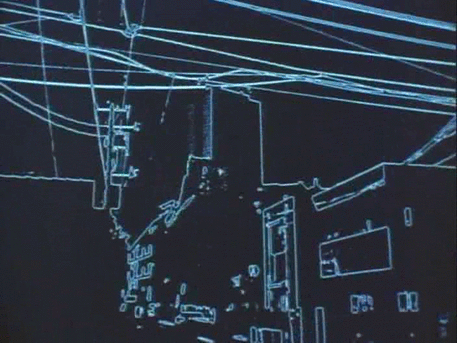

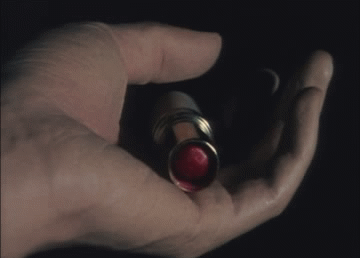
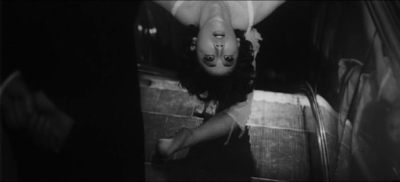

____________
Takahiko Iimura

‘Takahiko Iimura is an international artist and experimental filmmaker, who has been working with time-based media since the 1960. Throughout his career his work has investigated the structures of language and the differences and relationships between Eastern and Western ideas about time and space. At the same time he has been fascinated by the semiotics of film and video: their narrative stuctures and the way we ‘read’ both individual still images and moving audio-visual sequences.
‘Iimura came to New York in 1966, and became involved in the of avant garde movement there, which included artists Yoko Ono and Nam June Paik. Much of his work seeks to disrupt the ways we view film and video, often by paring it down to its essential, frame by frame elements in order that the audience become aware of its construction as much as its content. In this way he is also attempting to understand why we view moving images the way we do, whether that is projected on a cinema screen, through a TV monitor, or now on computers.’ — iniva.org
_______
Kuzu (Junks), 1962
‘Iimura films the cadavers of daily objects (junk) and animals without heads, cats, dogs or birds. While boats float calmly in the distance and children run along the beach, all kinds of larvae and insects move from old tatamis to old bottles under a “rain” of scratches caused by the numerous projections that the original film underwent. The object is thus rediscovered thanks to the images. It is not a question of showing “mono” (things), but rather “jibun no karada” (your own body) (Iimura) and the way in which you position yourself in relation to these things. Takehisa Kosugi: Music’ — collaged
_______
Ai (Love), 1963
‘LOVE, an Iimura film, 8mm and 16mm B/W 10minutes, using lenses of extremely short focal length and with magnifying lenses so that pubic hair and genitalia take on new and often unrecognizable aspects. Music is by Yoko Ono. Cast is anonymous. I have seen a number of Japanese avantgarde films at the Brussels international Experimental Film Festival, at Cannes, and at other places. Of all those films, Iimura’s LOVE stands out in its beauty and originality, a film poem, with no usual pseudo-surrealist imagery. Closest comparison would be Brakhage’s LOVING or Jack Smith’s FLAMING CREATURES. LOVE is a poetic and sensuous exploration of the body … fluid, direct, beautiful’. — Jonas Mekas
___________
Tetsuji Takechi

‘Tetsuji Takechi was a Japanese theatrical and film director, critic and author. First coming to prominence for his theatrical criticism, in the 1940s and 1950s he produced influential and popular experimental kabuki plays. Beginning in the mid-1950s, he continued his innovative theatrical work in noh, kyōgen and modern theater. In late 1956 and early 1957 he hosted a popular TV program, The Tetsuji Takechi Hour, which featured his reinterpretations of Japanese stage classics.
‘In the 1960s, Takechi entered the film industry by producing controversial soft-core theatrical pornography. His 1964 film Daydream was the first big-budget, mainstream pink film released in Japan. After the release of his 1965 film Black Snow, the government arrested him on indecency charges. The trial became a public battle over censorship between Japan’s intellectuals and the government. Takechi won the lawsuit, enabling the wave of softcore pink films which dominated Japan’s domestic cinema during the 1960s and 1970s. In the later 1960s, Takechi produced three more pink films.’ — collaged
____________________
Dream of the Red Chamber, 1964
‘A great piece of surrealist and erotic filmmaking, Takechi’s third film, The Dream of the Red Chamber or Crimson Dream (Kokeimu, 1964), was released less than two months after Daydream. The film depicts the lurid and violently erotic dreams of a writer, his wife and his sister, after having spent a night out drinking and visiting sex shows. The Dream of the Red Chamber underwent extensive censorship before the government would allow it to be released. About 20% of the film’s original content was cut by Eirin, rendering the film virtually incoherent, and this footage is now considered lost.’ — collaged
Trailer
__________
Day-Dream, 1964
‘Takechi produced his first significant work, Daydream (Hakujitsumu, 1964), an almost structureless succession of sexy set pieces revolving around a series of fantasies in a dentist’s waiting room, loosely based on a short story by Junichiro Tanizaki that had appeared in the September 1926 issue of the magazine Chuo Koron. It was when this independently produced work was picked up for distribution by Shochiku along with a number of similarly salacious titles that nudity began to become a legitimate subject for onscreen portrayal in its own right. A commercial success in Japan, it was released in the US the same year and later reissued there in 1966 with additional footage shot by its distributor Joseph Green, director of the 1962 cult bad film The Brain That Wouldn’t Die.’ — Midnight Eye
Trailer
______________
Toshio Matsumoto

‘One of the great pioneers of Sixties counter-cinema, Japanese director, video artist and critic Toshio Matsumoto (b. 1932) rose to prominence as a daring stylist and fearless provocateur whose radically experimental films shattered social and aesthetic taboos with inspired precision and energy. Matsumoto began as a documentary filmmaker, directing a series of abstract and subtly political shorts that applied a mode of poetic anthropology to postwar society and culture. Among Matsumoto’s earliest works were two important collaborations with fellow member of the Jikken-Kobo artist collective, the legendary composer Toru Takemitsu who contributed some of his earliest scores to Matsumoto’s lyrical documentaries Ginrin and Song of the Stone.
‘An influential critic and theorist, Matsumoto increasingly embraced formal experimentation, culminating in his dazzling three projector film, For My Crushed Right Eye and his incendiary feature film debut, Funeral Parade of Roses, one of the most important films produced by the remarkable independent distribution and production company Art Theater Guild. Making prominent use of music and mandala-like formal structures, Matsumoto’s deeply immersive and frequently psychedelic avant-garde films are trance inducing and quietly intense adventures in perception.’ — Harvard Film Archive
_______________
Funeral Parade of Roses, 1969
‘Trying to explain the pleasures of such a scrambled impressionistic piece as Funeral Parade of Roses in plot terms is a pretty fruitless exercise, although the disjointed narrative does reach fever pitch in the latter moments, with developments inspired by the ancient legend of Oedipus Rex. The story really remains only a ruse for a work that is best seen as a fascinating reflection of a long-vanished place and time, caught in a cross-current of international pop-cultural styles and influences and not dissimilar to what was going on in similar circles in other far-flung parts of the world. The colourful underground milieu, populated by a rag-tag collection of cross-dressers, bohemians, druggies and drop-outs, bares easy comparisons with the environment fostered by Andy Warhol and his disciples at his Factory studio in New York. Although its focus on experimental filmmaking technique is very much in keeping many of the other films produced by the Art Theatre Guild – typically those of Nagisa Oshima, Shohei Imamura, Masahiro Shinoda, Susumu Hani and Kiju Yoshida – Matsumoto’s film never quite seems like the dry meta-textual exercise in formalism of some of his contemporaries.’ — Midnight Eye
Trailer
Excerpt
_________
Metastasis, 1971
‘Writes Matsumoto, “I used the Erekutoro Karapurosesu (Electro Color Processor), which is mainly used in the field of medicine and engineering, to create moving image textures Metastasis, I was interested in layering images of a simple object and its electronically processed abstraction. The electronic abstract image is manipulated in a certain rhythm, depicting an organic process.”‘ — Electronic Arts Intermix
___________
Masao Adachi
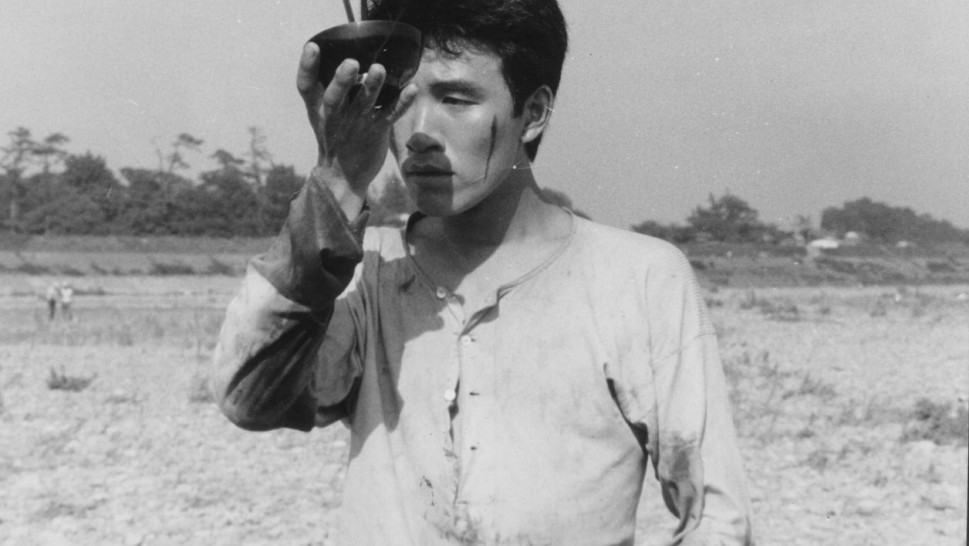
‘Born in 1939 in Kita Kyushu, Adachi emerged from the Nihon University Film Study Club, better known as Nichidai Eiken, alongside filmmakers like Motoharu Jonouchi and Isao Okishima, to become one of the leading figures in the underground experimental scene of the 60s, with films like Sain (1963) and Galaxy (1967). However, it is for his later associations with Nagisa Oshima, in whose Death by Hanging (1968) he appears in the role of the security officer, and more famously with Koji Wakamatsu, scripting dozens of his most famous titles including The Embryo Hunts in Secret, Go Go Second Time Virgin, Sex Jack, and Ecstasy of Angels, that he is best known.
‘Through Wakamatsu Productions, Adachi also contributed the pink genre’s most energetic and revolutionary titles, films such as Sex Play and High School Guerrilla. He furthermore became known as one of the country’s most progressive film theorists and critics due to his instrumental involvement with the journal Eiga Hihyo during its second phase from 1969 to 1973. And then he disappeared from Japan, apparently disillusioned with the direction along which the country’s commercial cinema was heading, leaving for Beirut where in 1974 he joined the Japanese Red Army in lending its assistance to the Popular Front for the Liberation of Palestine and their quest to fight for the liberation of the Israeli-occupied territories.’ — Midnight Eye
_______________
A.K.A. Serial Killer, 1969
‘The Japanese director, screenwriter and activist Masao Adachi is one. Active both in Japan’s avant-garde film scene of the 1960s and in the student-led protests against Tokyo’s controversial security treaty with Washington, Mr. Adachi wrote screenplays; directed movies like Female Student Guerrillas (1969), which infused the sexploitation genre with revolutionary politics; and developed a “theory of landscape,” which hypothesized that systems of power could best be revealed through filming not people but places. He put that theory into practice in the collectively directed AKA Serial Killer (1969), which recounts the killing spree of a 19-year-old man through images of the anonymous landscapes he traversed.’ — NYT
____________
Tokyo / Lebanon, 1971
‘Masao Adachi & Kôji Wakamatsu, both having ties to the Japanese Red Army, stopped in Lebanon on their way home from the Cannes festival. There they caught up with notorious JRA ex-pats Fusako Shigenobu and Mieko Toyama in training camps to create a newsreel-style agit-prop film based off of the “landscape theory” (fûkeiron) that Adachi and Wakamatsu had developed. Few artists have shifted from revolutionary imagination to revolutionary action like Masao Adachi.’ — collaged
_______
Takashi Ito
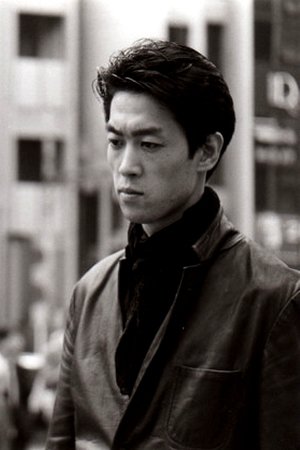
‘The films of Takashi Ito straddle the genres of animation and experimental film. Most of Ito’s films are animation in its fundamental sense of creating the illusion of movement through the rapid display of a sequence of images. Ito’s best works strip cinema down to its bare bones of being a series of photographs projected on a screen in rapid succession. In an article published in the Holland Animation Film Festival 2002 programme, Takashi Ito explains how his fascination with making his own films began when he was given an 8mm camera at university to shoot with. Watching the images he had shot, over and over again, Ito was struck by the power of cinema to bring inanimate things to life.
‘Ito decided to try to use the medium to create “films like fascinating nightmares” and began experimenting with photographing and manipulating images of clouds. His experimentation with film was bolstered by his coming into contact with Fukuoka’s independent screening organization FMF (Film-Makers’ Field) where a wide range of experimental and personal films are screened. As Ito himself described: “Film is capable of presenting unrealistic world as a vivid reality and creating a strange space peculiar to the media. My major intention is to change the ordinary everyday life scenes and draw the audience (myself) into a vortex of supernatural illusion by exercising the magic of films.”‘ — collaged
______
Ghost, 1984
‘In Ghost, as in many of his films, Ito explores some of the most basic dimensions of cinematic illusion, such as space depth, lightning and movement, to create a visual feast that seems to touch on the horror genre. But it’s not quite so, for the Ghost we are allowed to see is not designed to frighten but to mesmerize the spectators. Bulb shutters, long exposures and time-lapse are used to dazzle perception and insinuate the presence of floating life-forms in a closed space. Inagaki’s soundtrack kicks off with a steady electronic ambiance but soon descends into a hellish world of rhythmical distortion and mutli-dimensional lo-fi mayhem. I don’t think your children will be scared with this extraordinary piece, but if you do have them, please make them watch this in a closed dark room and report the results.’ — The Sound of Eye
_________
The Moon, 1994
‘A long time ago, I would often dream of the uncanny and mystical landscape that appears in moonlight. Irrational landscapes and spaces filled with unspeakable pleasures like a black object that revolves slowly while flying over the scattered clouds that float in the night sky, their lumps illuminated by the light of the moon.’ — TI
Excerpt
_________
Bonus track
_______________
Nobuhiko Obayashi’s House (1977)
‘Delirious, deranged, gonzo or just gone, baby, gone — no single adjective or even a pileup does justice to House, a 1977 Japanese haunted-house freakout. It’s easy to track the plot points in House and rather more difficult to grasp why Mr. Obayashi tells the story the way he does, to gauge the significance of the gaudy colors, the old-fashioned techniques (he periodically irises up and down), the superimpositions and flurries of jump cuts. The exterior backdrops tend to be overtly artificial, the skies so streaked with orange that you half expect to see Scarlett O’Hara shaking her fist at the heavens. A scene with Gorgeous, her father and his new squeeze, meanwhile, is shot through a multipaned window that separates the camera (and us) from the characters, one of several such distancing strategies. There are close-ups, but many are so glossy and stylized that they look like advertisements.’ — NYT
Trailer
House – Q&A with Director Nobuhiko Obayashi
*
p.s. Hey. ** Ian, Hi, Ian. Thanks on Joshua’s behalf. And on mine too. Were you able to max out your snow-imposed imprisonment? Sounds pretty. We’re already easing into spring here unfortunately. Ha ha, I’ve learned over the years that there are two things that it’s best not to ask French people about. Even cool French people. Because they get very uncomfortable and humorless and shocked that you would even bring them up. One is the brutality with which people who were perceived to have been Nazi sympathisers were tortured and murdered in the streets of Paris after WWII once the Nazis pulled out. The other is Pepe Le Pew. Seriously. Total bone of contention. ** David Ehrenstein, Morning, sir. ** Zak Ferguson, Hi, Zak. Good to see you. Experience vs. read in the sense of being overtaken vs. killing time? Think if books’ stuffs don’t start exploding in me to some degree, I stop reading them. Well, that new book of yours certainly sounds intriguing and even a little daunting? Re: the ‘welcome to the world’ slot, sometimes people ask, sometimes I decide to do it on my own. If you want to put that book in that slot, I’m game. I generally only do one ‘welcome’ post per author, so I guess be sure that’s the book yours that you want to have walk the blog’s wannabe red carpet. If so, I assume you know what those posts look/are like, how flexible they are, what they generally need to have in them. So go ahead and make said post if you like and send it to me if you want. Email: denniscooper72@outlook.com. Later and happiest day to you, dude. ** Misanthrope, Maybe in the second photo he was trying to show what he/Timothy would look like with prosthetics in case any customers were into that? Oh, boy, about David’s friend. Adios. David needs some nerdy pals stat. ** The Black Prince, The Black Prince! Nice. Hi, Prince! I’ve actually been approached by a few publishers inquiring if I wanted to write a sequel to ‘The Sluts’. Honestly, it would bore me to death. If there’s a sequel it will have to be written by someone else like when movie studios make sequels to ‘hit’ films, which is almost always a very bad idea. I think the escort/slave posts are the sequel, and, in their case, I didn’t write them either. Grr, ugh, about that mysterious sinister thing you’re dealing with. Be careful if you need to be. But hooray about the happy publisher for your next poetry book! Do you know when it’ll be published? That’s exciting! French hugs. ** Bill, No sighting of ‘Sator’ yet, but there are still a few unexplored horizons. ** Dominik, You would think, wouldn’t you. I know someone who used to live at the Cecil Hotel, and, yes, he said it was evil incarnate. Love working as a make-up artist on the goriest, scariest, lowest budget horror movie ever, G. ** Ferdinand, Hi F. I don’t know miserytourism, but I will now. Congratulations to them and you! Everyone, An exciting big up from Ferdinand, i.e. ‘(H)ave you heard of the lit site miserytourism? I have my first hosted short story there and what was so fun about this is that I got to doodle a selfportrait for an author pic and also create a sort of illustration for the story – so much fun. Here. And super ace about the SCAB score. Venues don’t get better than that one. Can’t wait. The 6 pm curfew is still extant, yes, and it’s maddening to say the least, yes. ** Josh Dalton, Hi, Josh! Thank you for using a bit of your precious electricity to come in here. And thank you again endlessly for the post. It was a hit. Big, big traffic. Whoo-hoo! Hope you’re all lit up again by now. ** Jack Skelley, Hi, Jazz-ck! I should do a Adam Schlesinger Day or Gig or something. Hmmm. Remember Linda Albertano? And her Casio? I was just thinking about them for some reason. Smooches! ** Brendan, B-ster! I’m getting the impression that you guys in LA are going to start sort of vaguely reopening to various degrees any second. Lucky dog pound, if so. Making lots of art is all I’ve got too. How have people who don’t make art lasted through this motherfucking mess? Oh, wait, Netflix, politics addiction, porn, … never mind. I will re: Lingua Ignota. It’s imminent, possibly today-level imminent. True about Bronson Cave. You know there was another Bat Cave (sort of). They filmed Wayne Manor at this cliff top mansion in Pasadena, this, and at the base of the cliff, for a short time, there was this decoration/prop thing connected to the cliff to make it look like there was an entrance to the Bat Cave right where the TV show claimed it was, but it was only ever shot at long distance, and it looked massively fake if you were less than half a mile or whatever from it, and my friends and I used to go there and smoke pot cradled by its fakeness. So now you know. And you probably already did. ** Steve Erickson, Hi. Yeah? Mm, just the name Eminem tends to ward me off. I like Foltekammer pretty well. Cool about that director being targeted. Things are looking up (?) (!). ** Jeff J, Hi, Jeff. I hope out of town was wondrously out of town. I have not seen ‘Wormwood’. I think it and the Steve Bannon doc are the two Morrises I haven’t seen. It might be on one of the illegal sites. That seems up its alley. I’ll check. I was really into early-to-mid Peter Handke at a certain point. I think I’ve read everything by him up to and including ‘Repetition’, which was/is my favorite of his. For whatever reason, I don’t think I’ve read anything of his after that. So, yeah, I do really like that early period of his work. Really good seeming thing to read. I’m happy to hear things settling over there. I’m good. Things are proceeding. Life is what it is. xo. ** Brian O’Connell, Good 10:07 am Paris time, Brian. I’ve always been terrible with money. It confuses me. Wow, 80s horror/ slasher is such a huge area, I’d have to really think to recommend things. In a way, they’re all good or else bad/good. I do think ‘Nightmare on…’ is by far the best of the franchises. Let me dwell and think. Ouch, about the Twitter cancel. Really, it’s a permanent deletion? That seems very extreme. Man, sorry, I totally get how at a time like this one that connective tissue is important. Hope you get to see your friends tonight. I’d love to see mine, but they’re all away. Sad face. Tuesday wasn’t too bad. I did my edit with my editor on ‘I Wished’, and now it’s off to be made into galleys, so that’s exciting. I sent film-related stuff to our producers. Now I have to get the film budgeted. We’ve only roughly guessed how much it will cost, but they need solid estimation by a week from now, so I have to find someone who knows how to budget films because Zac and I are not remotely experts. So I’m on that hunt starting today. And this and that. May Wednesday curtsy before you and ask you what you wish to happen during its tenure. Did it? ** Right. I’ve restored an old post that’s kind of a compendium of some awesome, somewhat like-minded, wild Japanese filmmakers. Fun to be had, if you like. See you tomorrow.




 Now available in North America
Now available in North America 
Yes, exactly that experience! I feel the book needs to make one implode in some sense, whether in irritation, exaltation, metaphysical orgasm, with synapses fired off, or I lose interest myself.
Thank you for that information, it is much appreciated. I will give it time to think which book I’d much prefer to have put in the DC red carpet consideration ballot.
Much like an actor I’ll be staring at myself in a mirror now, trying to drag myself up, and repeatedly muttering to myself: “should you/shouldn’t you/should you/shouldn’t you/!” – and think upon the work in general and whether I feel it should be galivanted to the world on your brilliant blog space.
I’m reading currently, History of a Drowning Boy, a heavily edited down version of renowned UK serial killer Dennis Nilsens’ 6000 page’s worth of reflection and memoir.
And the book is leaving me just bored, and, though I know his crimes, and the intrigue for myself to gain deeper insights into what led to his crimes and his rituals with those whom he killed is what I seek; the first 40 pages are just whimsy, the lead up is just off, too poetic and strategic in its aim and goal, and feels like as a reader he is lying to us – he is of course an unreliable source, even to his own story – but, lying for the sake of something, we as a reader and persons of moral standing will never condone, and its obvious in his prose, the desperation, to paint it as of something that isn’t even real or true to himself.
As if catering to us, in what he hope’s will engage us in his rituals and obsessions. It feels just very disingenuous and is just putting me off from caring what led him to his ritualistic murders.
As if trying rationalise his actions, in the first half of his story, in a ways to make it easier for us not to judge him upon his crimes. I was wondering whether you have read it yourself? I am struggling with it. It feels
off.
As always, yours sincerely, Zak
I am a big fan if “Funeral Parade of Roses” — a marvelous cinematic variation on Genet themes starring a great darg performer named “Peter.” His geatest role was as The Fool ” in “Ran,” Kurosawa’s magnificnt rendition of “King Lear”
Regarding French sensibilities I can certainly understand an aversion to “Pepe le Pew” — a Charles Boyer parody stretched beyond endurance. As for the treatment of collaborators one of the greatest of all French films is Resnais and Duras’ “Hiroshima Mon Amour” whose heroine (played with astonishing emotional and dramatic impact by Emmanuelle Riva) has an affair with german soldier during the occupation — who is killed. After the war her head is shaven, she’s publically humiliated and forced by her parents to live in their cellar before being sent to live in Paris and end their small toen disgrace. Do today;s French not want to “cancel” this masterpiece?
Big fan of Peta (Peter) in Funeral Parade of Roses. He is also made recordings, and I do have a best-of collection on CD. Pretty much Enka music. Thanks for presenting these Japanese filmmakers here. When I first went to Tokyo in 1989, I tried to think of a way to get these films shown at Beyond Baroque, but it was too much of an up-hill battle regarding budget, shipping, and getting people interested in such a program.
Dennis, Right? Though I consider David and all his friends nerds anyway, hahaha. Well, I guess they’re not. It’s just weed, videogames, and continuous-loop rap music turned up high 24/7 for them. I don’t know, sticking yourself in a small room with a bunch of other guys for hours on end…kinda not the coolest thing to me, but hey, that’s just me.
Reminds me of story from high school, though. My friends and I got up to a lot of no good stuff and got in some trouble too. My one friend, he lived across the street from this really nerdy kid (who seems to have done really well in life; I just looked him up). One day, my friend’s father stopped him outside and goes, “I hate all the bad stuff you and your friends have been getting up to, but thank God you’re not like that nerd across the street. I couldn’t handle it.”
Kind of a weird thing to say but I always found it funny. My friend, btw, he’s doing fine too.
Hi!!
I just watched the new Netflix documentary about Elisa Lam, and though I found the theories involving evil ghosts kind of ridiculous, I was pretty grateful that I wasn’t residing in the Cecil Hotel – then or any other time. The whole Skid Row area seems really exciting and interesting to me in its horrid ways, but I’m not sure I’d actually like to visit it.
Cool, I’d love to meet that love! Love chewing the same bubblegum for eight years, miraculously never suffocating in his sleep, Od.
Great stories of the eye today, heh. I’m only familiar with Funeral Parade of Roses. Will definitely explore further.
That’s an awesome cover for I Wished. Michael Salerno?
Saw “C.I.A.” at SF Indie Fest, an interesting faux documentary about violent Mexican street punks. I think it’s worth a look, but might be tough to get where you are.
Bill
Some beautiful images today! Sadly I’m unable to view films without headphones and here is why:
On Friday I got the Covid jab and it affected my mobility, my MS etc and as of yesterday I’m in the penthouse suite at Leeds General Infirmary being looked after by our sainted NHS. Will be here 3 days probably. After that I will be off to another physio place in Leeds for another 6 weeks! Obvs this is a lot to take in, only just found out this morning 😮
Will be absent from the Play Therapy radio show for a while and will keep you posted how all that works out.
So I am out of action temporarily. Still have my iPhone here in hospital and am happy to keep following the blog meantime.
Hi DC, ngl your French hugs made me feel soooo gooooood. Have you read The Black Prince (Iris Murdoch, 1973)? If so, do you love it? It’s one of my all time favourite novels. And she was my favourite novelist before you dethroned her. Anyway, I’m glad you seem to approve of my username.
Yes, I’ve always seen your slave posts as the sequel to The Sluts, too. And you’re absolutely right in that you don’t need to publish a sequel in the traditional way. In fact, this is actually more exciting, because like the Brad saga, it never finishes, and there is no resolution and yet it’s a gift that keeps on giving, and it’s uncontainable in the sense that it cannot be contained in an object/ book – as much as I love collecting books, I prefer your bi-weekly posts to any book format.
Poetry book will be published in February 2022… so exactly a year from now, which sounds torturously long to me to the point that I wrote a poem about how much I feel tormented by my impatience… the poem is now the last poem in the collection. So, it’s not bad. I have of course thanked you in Acknowledgements because of how much you encouraged/ inspired my writing. I actually meant to email you when I received the contract last month, but didn’t want to bother you as I know how busy you are xxx
Hey Dennis – What a fun post. I knew some of these filmmakers, but there’s a lot of material here that’s new to me. A friend here has a large collection of ‘pink films’ of the experimental variety and I hadn’t made some of the connections this post does with that work. Always been curious about Matsumoto’s experimental work beyond the great ‘Funeral Parade,’ too.
Had no idea Takechi did a film called ‘Dream of the Red Chamber’ – the use of that title in his context is an interesting travesty of the original novel.
Marked a bunch of these to watch tomorrow when I have some more time.
‘Wormwood’ is very much worth tracking down. J. Hoberman called it Morris’s best work, for whatever that’s worth to you. Be really curious to know how it hits you. I haven’t seen the Bannon doc either. Not sure my blood pressure could take hearing that guy’s voice for an extended period. Maybe in a few years…
I’ve been reading good things about Edgar Wright’s new Sparks documentary which premiered at Sundance. There’s an interesting video interview out there with him and the Mael brothers about the doc and Sparks 21 night concert of their albums, their shelved anime musical for Tim Burton, the new Carax, etc. that might be of interest?
Been caught on Sparks’ “Angst in My Pants” lately, it’s been on heavy repeat here. You have a favorite from that middle period of their work?
Hi Dennis!
How are things? Been a while, I hope the doughnuts that you were going to eat when I commented last time lived up to the anticipation!
Writing this at the butt end of a long old day, so will keep it brief! Just wanted to say that wow, experimental film, Japanese avant-gardes, pornography, revolution: today’s post scored a full house on the bingo card of things that I love! Can’t wait to dig in when I get some time over the weekend. Whilst the majority of these are unknown to me, I was previously aware of Adachi Masao and the crossover between radical politics and softcore porn…even though the concept is immediately appealing to me, I feel like it would make for a rubbish porno… But I will have to check that out for myself! Anyway, thanks for another great post.
T :))
Yeah I can’t imagine not making art in general, but this past year and really made me feel it. What else would I do? I do a fair share of the three things you mentioned, but that still a lot of time left in the day.
I didn’t know about the Wayne Manor house. But now I do. I think if I could go back in time, I’d pick the time young You we’re smoking pot in the fake-ass bat cave, and be there smoking pot with you.
B
Hey Dennis! Quinn here. I’m still floundering but thankfully my interpersonal life has straightened itself out, sort of. I’m just really struggling to focus, like I can hardly read a book much less work on my short story. But I’m going to stay positive. The sun came out today and it brought me great pleasure, I went on a walk on my lunch break and it was splendid.
Hey, the Brontez piece came out today, here is a link in case you’re curious! https://www.interviewmagazine.com/culture/brontez-purnell-new-book-100-boyfriends-feels-right-at-home-in-2021
Hope everything’s good with you. Any new news? Keeping healthy? I’m writing this from the office and am rushing out so sorry for the brief message. Catch ya later DC!
Mind blown
Mind blown by these films i mean. Wow what a great post.
MY LATEST FABLOG IN WHICH I CELEBRATE THE DEATH OF RUSH LIMBAUGH
The only way I can see a sequel to THE SLUTS working is if you go totally meta and write chapters as fanfiction about the novel, tweets discussing it in comparison to other fiction of its period, and incorporate these slave/escort ads into it.
This day is a great starting point. FUNERAL PARADE OF ROSES is brilliant, and Masao Adachi & Koji Wakamatsu’s film about the PFLP is extremely dated, but a fascinating document of ’70s radical politics.
Here’s my review of FILMFARSI, a documentary about Iranian genre films made between the 1953 coup and 1979 revolution: https://www.screenslate.com/articles/527?mc_cid=48f9ac1853&mc_eid=44d4e196d3
I wrote a song today based on a stretched-out vocal sample: https://callinamagician.bandcamp.com/track/stretch-and-wave-your-hands. It began as a 15-second bit of Autotuned self-harmonizing from a hip-hop song, but slowed down 10 times, it sounds more like a liturgal choir. (The song ends with the original sample.) The rest of the song was written around it.
Merry Thursday, Dennis,
After class tomorrow I’m going to just dive right into this post and hopefully excavate some of its many riches. Japanese cinema is just so great, and I’m currently pretty inexperienced with its more experimental side, so this will provide an excellent starting point. Thanks a million.
The “Nightmare” franchise is where I’ll start, then. I really liked the first film, which sort of surprised me: I’d assumed its overwhelming cultural status might weaken its power, but it still played really well and unsettling and strange, which is always great. So I’ll check out the others. Obviously I’ve heard a lot about the second film, and I know a few people who cherish the third, so that should be interesting.
Fortunately (or really very unfortunately, depending on how you look at it) Twitter did decide to restore my account today after I appealed. The problem was that they discovered I’d joined back in November 2015, when I was three months shy of 13, the minimum age required of its users. So they were ready to junk the entire account, but after some back-and-forth they unlocked it on the condition that they get to erase what little pre-13 stuff is actually there, which is more of a favor to me than anything else, honestly. So there, for better or for worse—probably for worse, but…—I’m back.
I did get to see my friends tonight, thankfully; we watched (rewatched, for me) that weird documentary “Tickled” (have you seen it? Highly recommend if you haven’t) and “Perfect Blue”, it was fun. That was my day. I’m so sorry your friends are away. That sucks. May they return soon. Yay, that “I Wished” news is terribly exciting, for me as well as for you, because (as I think I’ve said to you) the eventual release of “I Wished” is one of the only things I’m really looking forward to this year. Ugh, budgeting. Good luck with that! Yes, if my Wednesday didn’t quite curtsy before me, it at least gave me a friendly nod, which I appreciated. Yours?